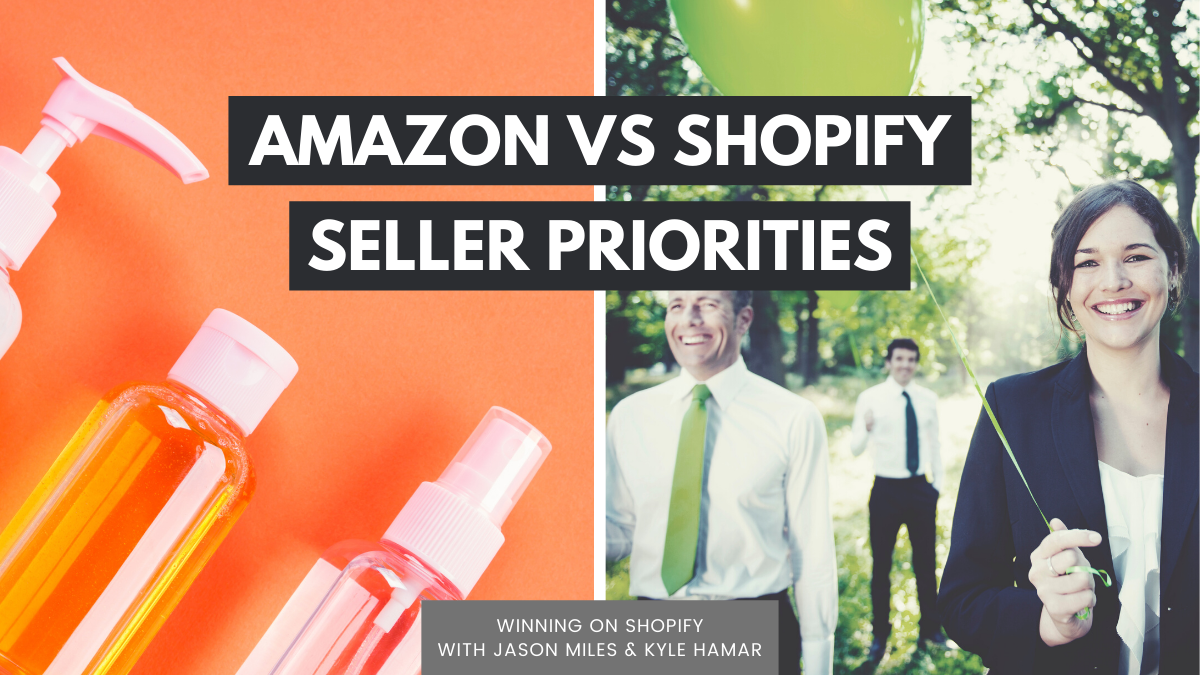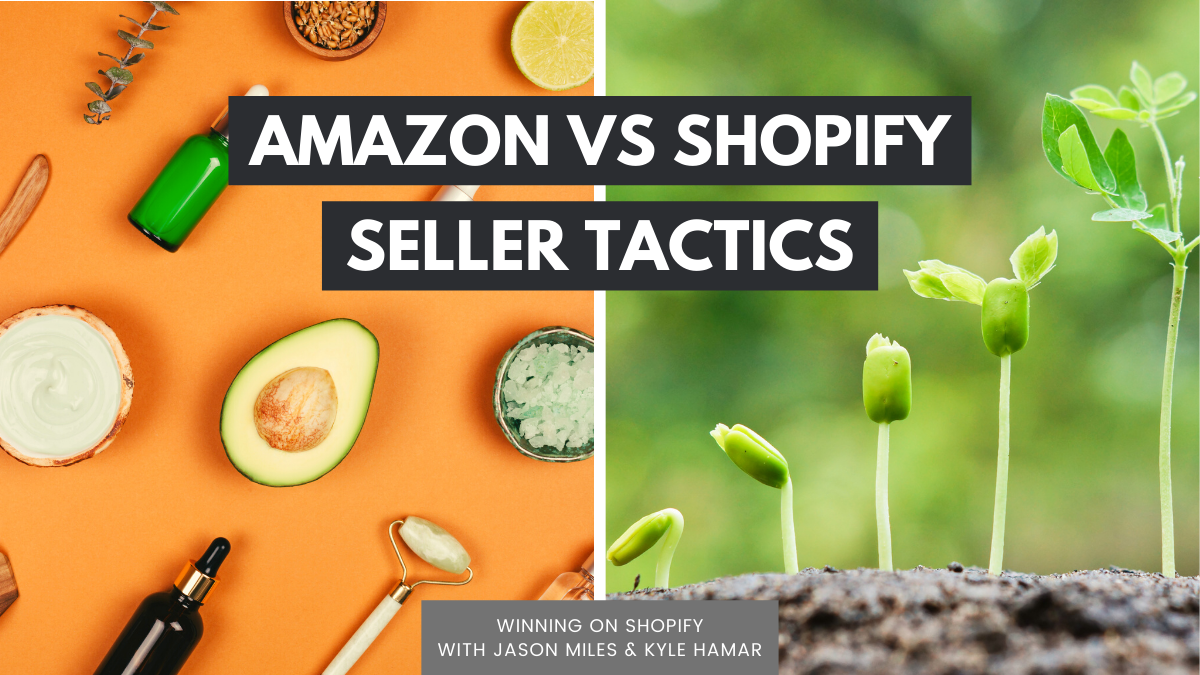Amazon Sellers Vs. Shopify Sellers 30 Differences

When I launched my Shopify Power course on Udemy (in June 2016) I wasn't sure anyone would notice. Since then I've had the privilege of working with over 1,300 new Shopify site owners and it's been a blast!
Many of them come to me as successful Amazon sellers. I love helping them launch Shopify sites so they can create a second source of online income.
I've come to realize there is a big difference in the mindset / priorities / and tactics between selling on Amazon and selling on Shopify.
• Mindset
• Priorities
• Tactics
So in this article, I'll share the differences I've seen (many of them in the form of a question). If you enjoy this content, you'll also enjoy our Amazon To Shopify webinar.

Amazon Mindset Vs. Shopify Mindset
Many Amazon sellers I've met have a merchants-mindset. Let me explain. When I was a kid we lived 30 minutes away from the largest Saturday market in California, Denios Farmers Market & Auction. It's amazing. We would go every few years and I loved it. It included hundreds of merchants - all selling various do-dads.
The merchants knew that they would have a FLOOD of visitors each weekend, so their only question was related to finding that magic product that was both source-able, sellable, and profitable.
In a similar way, Amazon sellers are intensely targeted in their thinking to ask and answer these top-of-mind questions including:
1. Does the product sell often (rank & velocity)?
2. Do I have a source of it that I can purchase?
3. After fees, is there a margin I can make?
The astute observer will notice immediately that these aren't customer focused questions. They are product focused questions. Nothing wrong with that - since selling on Amazon successfully requires you to think that way.
Many Shopify sellers I've worked with, on the other hand, have what I call a Food Truck mentality. Let me explain. A Food Truck driver cannot assume she/he will have any customers unless they solve a couple obvious problems. Their top of mind questions include:
1. Where are the customers and can I park there?
2. Can I make (or sell) something they'll want to buy?
3. Can I create a bond with them so they return?
Of course, you'll notice the difference between the two mindsets immediately. While the Amazon seller operates with assumed traffic, the Shopify seller cannot. Different priorities emerge.
As a side note, after speaking with many Amazon sellers, I've noticed that they tend to make the "there won't be any traffic if I sell off Amazon" boogeyman really scary in their mind - and built that challenge up to something that is unachievable in their mind. It's generally their top fear, but it stems from their mindset. In other words, they come from a place mentally that makes them focus on this topic.

Amazon Seller Priorities Vs. Shopify Seller Priorities
Amazon sellers have a short-list of priorities that go something like this:
1. Source profitable product(s)
2. Process it - and send it to Amazon
3. Manage prices and/or ads to optimize profit
An Amazon seller that wants to scale to a six or seven figure level has to prioritize their time (or team's time) to accomplish these tasks at an industrial level.
Shopify sellers (at least many of them that I've spoken with) have a short-list of priorities that go something like this:
1. Find and cultivate profitable prospects, (via organic and paid strategies)
2. Optimize products for them to maximize sales
3. Plan and execute promotions
The difference in priorities are pretty clear. The Amazon sellers start by sourcing products. The Shopify sellers start by sourcing prospects.
In fact, many of the best Shopify sellers I've seen source prospects (a crowd) before they know what they are going to sell them (how would you know what they want before you get to know them).
And, some of the worst Shopify sellers I've seen start by creating a product and then they try, without any luck, to find an audience that they can bring to their Shopify site to sell them.
What are the questions for each approach?
A product sourcer has a priority on answering these questions:
1. What is it?
2. How popular is it in Amazon?
3. How much does it sell for?
4. What can I buy it for?
5. Are there any special issues that make it a bad idea, (weight, toxicity, perishability, etc.)?
A prospect sourcer has a priority on answering these questions:
1. Who are these people?
2. What are their felt needs (emotional prompts to buy)?
3. What do they actually buy to meet this felt need?
4. How often do they buy it?
5. How much do they pay and is there a wide range?
6. Do they demonstrate any brand loyalty?
7. Can I meet their needs in a way that will stand out?

Amazon Seller Tactics Vs. Shopify Seller Tactics
The final difference I notice is in the tactics involved in scaling up as an Amazon seller versus a Shopify seller.
An Amazon seller employs these tactics to scale up:
1. Find a source of profitable product and buy as much as possible without letting ANYONE know what you're doing (the secrecy is important). This can be via pure sourcing or listing techniques such as creating bundles.
2. Focus on getting in the Buy-Box through competitive pricing and/or seller review/ratings management.
3. Sell-through quickly and liquidate slow moving (or zero profit) inventory by lowering prices or running ads to boost visibility.
A Shopify seller employs these tactics to scale up:
1. Optimize email marketing (and other cultivation techniques) to create return visits and thereby improve long-term customer value.
2. Test new marketing channels to determine the best sources of long-term customer acquisition. Invest, or divest depending on test outcomes.
3. Optimize product mix to boost average order value, thereby boosting long-term customer value.
If you add up each of the points of difference in this article, it's something like 30 topics - wow! I'm sure I'm just scratching the surface.
If you are an Amazon seller and you're considering adding a Shopify site to your online income, then my final piece of advice would be:
"Don't fear Shopify, but don't go into it thinking that it works that same way Amazon works. They are two different worlds and it will require you to learn a new mindset, priorities, and tactics."
The good news is that almost 300,000 people are now using Shopify - so clearly it's achievable if you want it badly enough. I'm happy to be your coach/mentor/friend as you start that journey.
Get A Free 30 Minute Consultation When You Apply For Personal Coaching: As part of the coaching application process we offer a free 30 minute consultation. It is our opportunity to meet each other and discover together if coaching is a good fit. If you're ready to get our personal help. Learn more here.
If you'd like additional training and coaching to achieve your Shopify goals, consider applying for our coaching program today!
Grateful for the chance to be of help,
Jason & Kyle


